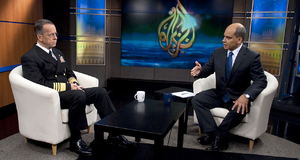The Daily Show’s ability to reveal hypocrisy is essential to fostering more honest and open discourse. In order to do that, though, people must take notice of the show’s efforts. The New York Times online blog, for instance, promoted the Postcards from the Pledge clip, prompting comments and attention from Internet users. Former Vice President Al Gore took notice of a video that presented Dick Cheney’s blatant hypocrisy. Gore valued it enough to even reference it in one of his recent books about the how politics of fear and secrecy have impacted rational discourse:
“Vice President Cheney lashed out at The New York Times for having the nerve to print a headline declaring PANEL FINDS NO QAEDA-IRAQ TIE – which was by then merely a clear statement of the obvious. Piling one falsehood on top of another, Cheney then said that there was no “fundamental split here and now between what the president said and what the commission said.” He even tried to deny that he had ever personally been responsible for helping to create the false impression that there was linkage between al-Qaeda and Iraq. Appropriately enough, his interview ended up as fodder for The Daily Show with Jon Stewart. Stewart played Cheney’s outright denial that he had ever said that representatives of al-Qaeda and Iraqi intelligence met in Prague, and then Stewart froze Cheney’s image and played the exact video clip when Cheney had indeed said exactly that in exactly the words he had denied. He caught him on videotape in a blatant lie. At that point, Stewart said, addressing himself to Cheney’s frozen image on the television screen, “It’s my duty to inform you that your pants are on fire.””
Clips often now serve as reference sources for politicians, authors, and members of the media for their own purposes. Whether it is to expose certain irrationalities or to just mock, the clips educate, albeit pessimistically, about the political process as a whole. Nevertheless, the outcome is a more aware public that presumably will translate into a more accountable government.
From conservative political commentators to Democratic presidents, Stewart seeks to point out hypocrisy wherever it exists. Despite its liberal leanings, The Daily Show, when presented with an opportunity to expose hypocrisy within the political system, does not exempt the Democrats and liberal news figures from criticism either. Hypocrisy from any perspective only prevents honest debate from taking place, and by holding influential figures accountable for their statements, The Daily Show will likely reduce inconsistency and duplicity, thereby improving the accountability of the political process and government.
In a fascinating foray into the legislative policy debate, The Daily Show was a vital factor in the passage of the bill providing health care to 9/11 first responders. Starting in August 2010, with a lengthy video segment devoted to criticizing both parties for failing to pass the bill, The Daily Show reprimanded opponents of the bill. However, when the bill failed that summer, the fate of the bill became unknown. During the lame-duck legislative session that year, the Democrats brought it up for debate once again, but again other issues received the spotlight and priority.
From the beginning of December 2010, The Daily Show ridiculed the senators who opposed the bill. The national debate at the time was dominated by the Republican demand that the Bush-era tax cuts be extended for the wealthiest Americans before any other legislation was to be considered. Regardless, of one’s stand on the tax cuts issue, Stewart argued that it was ridiculous for the tax issue to be the moral obstacle preventing consideration of the 9/11 health care bill. Stewart affirmed that the 9/11 health care bill was “kind of a no-brainer politically and… morally – kind of the right thing to do.”
In the middle of December, approaching the end of the congressional session, there were low expectations for the bill’s passage. The Daily Show devoted its entire last show of the year, on December 16th, to advocating for the passage of the 9/11 health care bill. The first segment chastised the bill’s opponents and lack of media coverage: “None of the three broadcast networks [(NBC, CBS, and ABC)] have mentioned any of this on their evening newscasts for two and a half months, although, to be fair, it’s not every day that Beatles songs come to iTunes.” He also derided Fox News, despite the network’s typical passion on 9/11-related injustices, for not adequately covering the issue and the Republican filibuster of the bill. In the second part of the show, Stewart discussed the issue directly with four emergency first responders from September 11th, 2001 who were suffering from significant medical problems directly related to their rescue efforts. The episode concluded with an interview with Mike Huckabee in which both Stewart and Huckabee discussed the bipartisan nature of the issue and urged the Republican senators to support the bill.
The episode marked an important point for The Daily Show, not only because it was one of the few episodes dedicated to a single issue, but also because of the direct impact that it had on the national debate. On December 20, 2010 The Daily Show was acknowledged by TIME as having lit a fire under the issue, with the news networks covering the issue more closely, an increase in Senate action with newfound optimism, and Chris Wallace of Fox News deeming the lack of action a “national shame.” Sheppard Smith of Fox News also noted the importance of The Daily Show on the lack of bipartisan support:
“But both sides didn’t come to the same page after the tax deal went through. Both sides came to the same page when Jon Stewart did an entire hour – his last hour of the year – on this and brought on people who were dying. And it took that to get this done… to even get people to talk about it.”
The legislation finally passed the Senate on December 22nd, and in an article in The New York Times that day, Stewart was cited as having brought “national attention” to the bill. CBS News further reported that both White House Press Secretary Robert Gibbs and Senator Chuck Schumer credited Stewart with generating the necessary attention to and awareness of the bill. In The New York Times a week later, New York City Mayor, Michael Bloomberg, remarked on Stewart’s pressure:
“Success always has a thousand fathers, but Jon shining such a big, bright spotlight on Washington’s potentially tragic failure to put aside differences and get this done for America was, without a doubt, one of the biggest factors that led to the final agreement.”
The Times subsequently classified Stewart’s efforts as “advocacy journalism,” drawing comparisons to the journalistic activism of Edward Murrow and Walter Cronkite. Kirsten Gillibrand, a New York Senator and leading advocate for the bill, appeared on The Daily Show the following January and amidst the discussion, strongly contended that the show made a difference and that Stewart “put a spotlight on an issue and… amplified the work of all the first responders.”
Without a doubt, The Daily Show was integral in reviving the necessary passion and support for passing the 9/11 health care bill. The show utilized its existing reach and likely exceeded its expectations for the amount of public and media attention it received. Issue advocacy to such an extent was a new approach for Stewart and The Daily Show team. Although Stewart had previously advocated for changes in public discourse, supporting a specific piece of legislation at such a level was an entirely new pursuit. It was virtually unheard of for Stewart to champion a specific policy and to receive such acknowledgement for his dedication to and pressure for the issue.Continued on Next Page »
1.) Baym, Geoffrey. “The Daily Show: Discursive Integration and the Reinvention of Political Journalism.” Political Communication. 2005. 22: 3, 259-276.
Brewer, Paul R. and Emily Marquardt. “Mock News and Democracy: Analyzing The Daily Show.” Atlantic Journal of Communication. Lawrence Erlbaum Associates, Inc. 2007. 15:4, 249-267.
4.) “Remembering Anna.” The Daily Show with Jon Stewart. Comedy Central. February 12, 2007. Web. October 26, 2010. <http://www.thedailyshow.com/watch/mon-february-12-2007/remembering-anna>.
5.) “Shut Up Mark Sanford.” The Daily Show with Jon Stewart. Comedy Central. July 12, 2009. Web. October 26, 2010. <http://www.thedailyshow.com/watch/thu-july-2-2009/shut-up--mark-sanford>.
6.) “The Wedding of the Century of the Millennium.” The Daily Show with Jon Stewart. Comedy Central. August 2, 2010. Web. October 26, 2010. <http://www.thedailyshow.com/watch/mon-august-2-2010/wedding-of-the-decade-of-the-century-of-the-millennium >.
“Headlines Duke Lacrosse Rape Allegations.” The Daily Show with Jon Stewart. Comedy Central. April 18, 2006. Web. October 26, 2010. <http://www.thedailyshow.com/watch/tue-april-18-2006/headlines---duke-lacrosse-rape-allegations>.
9.) “Headlines Duke Lacrosse Rape Allegations.” The Daily Show with Jon Stewart. Comedy Central. April 18, 2006. Web. October 26, 2010. <http://www.thedailyshow.com/watch/tue-april-18-2006/headlines---duke-lacrosse-rape-allegations>.
10.) “Journalism, Satire or Just Laughs? ‘The Daily Show with Jon Stewart,’ Examined.” Pew Research Center’s Project for Excellence in Journalism. N.p., May 8, 2008. Web. October 26, 2010. <http://www.journalism.org/node/10953>.
11.) Who the f@#k is that guy? – Political Experts.” The Daily Show with Jon Stewart. Comedy Central. October 22, 2008. Web. October 28, 2010. <http://www.thedailyshow.com/watch/wed-october-22-2008/who-the-f--k-is-that-guy----political-experts>.
13.) “Hi Tech News Coverage.” The Daily Show with Jon Stewart. Comedy Central. January 9, 2008. Web. October 28, 2010. <http://www.thedailyshow.com/watch/wed-january-9-2008/hi-tech-news-coverage>.
14.) “Speech Therapy.” The Daily Show with Jon Stewart. Comedy Central. January 28, 2010. Web. November 4, 2010. <http://www.thedailyshow.com/watch/thu-january-28-2010/speech-therapy---post-racial>.
15.) “CNN Leaves It There.” The Daily Show with Jon Stewart. Comedy Central. October 12, 2009. Web. November 1, 2010. <http://www.thedailyshow.com/watch/mon-october-12-2009/cnn-leaves-it-there>.
17.) “CNN Leaves It There.” The Daily Show with Jon Stewart. Comedy Central. October 12, 2009. Web. November 1, 2010. <http://www.thedailyshow.com/watch/mon-october-12-2009/cnn-leaves-it-there>.
18.) “MSNBC Left Behind.” The Daily Show with Jon Stewart. Comedy Central. October 11, 2010. Web. November 3, 2010. <http://www.thedailyshow.com/watch/mon-october-11-2010/msnbc-left-behind>.
19.) “Keith Olbermann’s Name Calling.” The Daily Show with Jon Stewart. Comedy Central. January 21, 2010. Web. November 4, 2010. <http://www.thedailyshow.com/watch/thu-january-21-2010/special-comment---keith-olbermann-s-name-calling>.
20.) “Speech Therapy.” The Daily Show with Jon Stewart. Comedy Central. January 28, 2010. Web. November 4, 2010. <http://www.thedailyshow.com/watch/thu-january-28-2010/speech-therapy---post-racial>.
21.) “Fox News.Com.” Fox News Network, LLC. November 4, 2010. 2010. <http://www.foxnews.com/>.
22.) “For Fox Sake.” The Daily Show with Jon Stewart. Comedy Central. October 29, 2009. Web. November 4, 2010. <http://www.thedailyshow.com/watch/thu-october-29-2009/for-fox-sake->.
24.) “Anchor Management.” The Daily Show with Jon Stewart. Comedy Central. March 3, 2010. Web. November 4, 2010. <http://www.thedailyshow.com/watch/wed-march-3-2010/anchor-management>.
“Gretchen Carlson Dumbs Down.” The Daily Show with Jon Stewart. Comedy Central. December 8, 2009. Web. November 6, 2010. <http://www.thedailyshow.com/watch/tue-december-8-2009/gretchen-carlson-dumbs-down>.
“Sean Hannity Uses Glenn Beck’s Protest Footage.” The Daily Show with Jon Stewart. Comedy Central. November 10, 2009. Web. November 6, 2010. <http://www.thedailyshow.com/watch/tue-november-10-2009/sean-hannity-uses-glenn-beck-s-protest-footage>.
33.) “Sean Hannity Apologizes to Jon.” The Daily Show with Jon Stewart. Comedy Central. November 12, 2009. Web. July 16, 2011. <http://www.thedailyshow.com/watch/thu-november-12-2009/sean-hannity-apologizes-to-jon>.
34.) “Are You Ready For Some Midterms? – MSNBC’s Political Narrative.” The Daily Show with Jon Stewart. Comedy Central. September 9, 2010. Web. November 6, 2010. <http://www.thedailyshow.com/watch/thu-september-9-2010/are-you-ready-for-some-midterms----msnbc-s-political-narrative>.
35.) “Kurtz criticizes Hannity's "careful editing" of Obama speech: "Isn't that kind of editing, what's the word, deceptive?" Media Matters For America. September 12, 2010. Web. November 6, 2010. >.
36.) “Bernie Goldberg Fires Back.” The Daily Show with Jon Stewart. Comedy Central. April 20, 2010. Web. November 6, 2010. <http://www.thedailyshow.com/watch/tue-april-20-2010/bernie-goldberg-fires-back>.
37.) “Top TV Feuds: Jon Stewart vs. Crossfire.” TIME. Time.com. 2010. <http://www.time.com/time/specials/packages/article/0,28804,1884499_1884515_1884462,00.html>.
Gollmitzer, Mirjam. "Towards a Media Incidents Theory: How "Adversarial Guests" Ruin Programs and Liberate the Audience."Conference Papers -- International Communication Association(2009): 1-20. Communication & Mass Media Complete. EBSCO. Web. 20 Nov. 2010.
44.) Douthat, Ross. “Can CNN Be Saved?” The New York Times. April 4, 2010. <http://www.nytimes.com/2010/04/05/opinion/05douthat.html>.
Snow, Nancy. “Jon Stewart: Still the Most Trusted Newscaster in America.” The Huffington Post. July 23, 2009. <http://www.huffingtonpost.com/nancy-snow/jon-stewart-still-the-mos_b_243646.html>.
47.) Gollmitzer, Mirjam. "Towards a Media Incidents Theory: How "Adversarial Guests" Ruin Programs and Liberate the Audience."Conference Papers -- International Communication Association(2009): 1-20.Communication & Mass Media Complete. EBSCO. Web. 20 Nov. 2010.
“CNBC Financial Advice.” The Daily Show with Jon Stewart. Comedy Central. March 4, 2009. Web. November 20, 2010. <http://www.thedailyshow.com/watch/wed-march-4-2009/cnbc-financial-advice>.
52.) Cramer, Jim. “Cramer Takes on White House, Frank Rich, and Jon Stewart.” The Street. MainStreet.com. March 10, 2009. <http://www.mainstreet.com/article/moneyinvesting/news/cramer-takes-white-house-frank-rich-and-jon-stewart?page=4>.
“In Cramer We Trust.” The Daily Show with Jon Stewart. Comedy Central. March 9, 2009. Web. November 20, 2010. <http://www.thedailyshow.com/watch/mon-march-9-2009/in-cramer-we-trust>.
“Basic Cable Personality Clash Skirmish.” The Daily Show with Jon Stewart. Comedy Central. March 10, 2009. Web. November 20, 2010. <http://www.thedailyshow.com/watch/tue-march-10-2009/basic-cable-personality-clash-skirmish--09>.
“Jim Cramer Extended Interview Pt. 1.” The Daily Show with Jon Stewart. Comedy Central. March 12, 2009. Web. November 21, 2010. <http://www.thedailyshow.com/watch/thu-march-12-2009/jim-cramer-extended-interview-pt--1>.
“Jim Cramer Extended Interview Pt. 2.” The Daily Show with Jon Stewart. Comedy Central. March 12, 2009. Web. November 21, 2010. <http://www.thedailyshow.com/watch/thu-march-12-2009/jim-cramer-extended-interview-pt--2>.
“Jim Cramer Extended Interview Pt. 3.” The Daily Show with Jon Stewart. Comedy Central. March 12, 2009. Web. November 21, 2010. <http://www.thedailyshow.com/watch/thu-march-12-2009/jim-cramer-extended-interview-pt--3>.
64.) Snow, Nancy. “Jon Stewart: Still the Most Trusted Newscaster in America.” The Huffington Post. July 23, 2009. <http://www.huffingtonpost.com/nancy-snow/jon-stewart-still-the-mos_b_243646.html>.
65.) France, Lisa Respers. “Stewart seen as winner in Showdown with Cramer.” March 19, 2009. CNN.com. 2009. <http://www.cnn.com/2009/SHOWBIZ/TV/03/13/cramer.stewart.reaction/index.html?iref=allsearch>.
66.) Carlson, Tucker. “How Jon Stewart Went Bad.” The Daily Beast: Blogs & Stories. March 18, 2009. RTST, Inc. 2010. <http://www.thedailybeast.com/blogs-and-stories/2009-03-18/how-jon-stewart-went-bad/>.
67.) Fisher, Luchina. “Jon Stewart Wins Cramer Showdown.” March 13, 2009. ABC News Internet Ventures. 2010. <http://abcnews.go.com/Entertainment/Television/story?id=7075368&page=1>.
68.) Cohen, Richard. “Don’t Blame Jim Cramer.” The Washington Post. March 17, 2009. <http://www.washingtonpost.com/wpdyn/content/article/2009/03/16/AR2009031602319.html>.
France, Lisa Respers. “Stewart seen as winner in Showdown with Cramer.” March 19, 2009. CNN.com. <http://www.cnn.com/2009/SHOWBIZ/TV/03/13/cramer.stewart.reaction/index.html?iref=allsearch>.
“Journalism, Satire or Just Laughs? ‘The Daily Show with Jon Stewart,’ Examined.” Pew Research Center’s Project for Excellence in Journalism. N.p., May 8, 2008. Web. October 26, 2010. <http://www.journalism.org/node/10953>.
72.) “Mike Huckabee Pt.2.” The Daily Show with Jon Stewart. Comedy Central. December 9, 2008. Web. April 21, 2011. <http://www.thedailyshow.com/watch/tue-december-9-2008/mike-huckabee-pt--2>.
“Newt Gingrich.” The Daily Show with Jon Stewart. Comedy Central. February 9, 2010. Web. April 21, 2011. <http://www.thedailyshow.com/watch/tue-february-9-2010/newt-gingrich>.
“Exclusive John Yoo Extended Interview Pt.1.” The Daily Show with Jon Stewart. Comedy Central. January 11, 2010. Web. April 21, 2011. <http://www.thedailyshow.com/watch/mon-january-11-2010/exclusive---john-yoo-extended-interview-pt--1>.
77.) “Exclusive Marc Thiessen Extended Interview Pt.1.” The Daily Show with Jon Stewart. Comedy Central. March 9, 2010. Web. April 21, 2011. <http://www.thedailyshow.com/watch/tue-march-9-2010/exclusive---marc-thiessen-extended-interview-pt--1>.
78.) Douthat, Ross. “Can CNN Be Saved?” The New York Times. April 4, 2010. <http://www.nytimes.com/2010/04/05/opinion/05douthat.html>.
79.) “Exclusive John Yoo Extended Interview Pt.3.” The Daily Show with Jon Stewart. Comedy Central. January 11, 2010. Web. April 21, 2011. <http://www.thedailyshow.com/watch/mon-january-11-2010/exclusive---john-yoo-extended-interview-pt--3>.
80.) “Barack Obama Pt.1.” The Daily Show with Jon Stewart. Comedy Central. October 27, 2010. Web. April 30, 2011. <http://www.thedailyshow.com/watch/wed-october-27-2010/barack-obama-pt--1>.
81.) “Eye to Eye: Obama on Stewart (CBS News).” CBS News. YouTube. August 23, 2007. <http://www.youtube.com/watch?v=6f3nQPJfgPo&feature=fvw>.
“Journalism, Satire or Just Laughs? ‘The Daily Show with Jon Stewart,’ Examined.” Pew Research Center’s Project for Excellence in Journalism. N.p., May 8, 2008. Web. October 26, 2010. <http://www.journalism.org/node/10953>.
84.) Douthat, Ross. “Can CNN Be Saved?” The New York Times. April 4, 2010. <http://www.nytimes.com/2010/04/05/opinion/05douthat.html>.
85.) Baym, Geoffrey. “The Daily Show: Discursive Integration and the Reinvention of Political Journalism.” Political Communication. 2005. 22: 3, 259-276.
86.) “So You Think You Can Douche.” The Daily Show with Jon Stewart. Comedy Central. July 29, 2009. Web. April 30, 2011. <http://www.thedailyshow.com/watch/wed-july-29-2009/so-you-think-you-can-douche>.
87.) “Sarah Palin Gender Card.” The Daily Show with Jon Stewart. Comedy Central. September 3, 2008. Web. April 30, 2011. <http://www.thedailyshow.com/watch/wed-september-3-2008/sarah-palin-gender-card>.
88.) “Sarah Palin Gender Card.” The Daily Show with Jon Stewart. Comedy Central. September 3, 2008. Web. April 30, 2011. <http://www.thedailyshow.com/watch/wed-september-3-2008/sarah-palin-gender-card>.
89.) “Postcards From the Pledge.” The Daily Show with Jon Stewart. Comedy Central. September 23, 2010. Web. April 30, 2011. <http://www.thedailyshow.com/watch/thu-september-23-2010/postcards-from-the-pledge>.
90.) “Postcards From the Pledge.” The Daily Show with Jon Stewart. Comedy Central. September 23, 2010. Web. April 30, 2011. <http://www.thedailyshow.com/watch/thu-september-23-2010/postcards-from-the-pledge>.
“Moral Kombat.” The Daily Show with Jon Stewart. Comedy Central. May 14, 2009. Web. April 30, 2011. <http://www.thedailyshow.com/watch/thu-may-14-2009/moral-kombat>.
93.) Shear, Michael. “From Jon Stewart, Echoes of G.O.P. Past.” The New York Times. September 24, 2010. <http://thecaucus.blogs.nytimes.com/2010/09/24/from-jon-stewart-echoes-of-g-o-p-past/?scp=1&sq=jon%20stewart%20postcards%20from%20the%20pledge&st=cse>.
94.) Gore, Al. The Assault on Reason. Penguin Books. New York, NY. 2007. 111.
95.) “I Give Up – 9/11 Responders.” The Daily Show with Jon Stewart. Comedy Central. August 4, 2010. Web. April 30, 2011. <http://www.thedailyshow.com/watch/wed-august-4-2010/i-give-up---9-11-responders-bill>.
96.) “Republicans Block 9/11 Health Care Bill.” The Daily Show with Jon Stewart. Comedy Central. December 9, 2010. Web. April 30, 2011. <http://www.thedailyshow.com/watch/thu-december-9-2010/republicans-block-9-11-health-care-bill>.
97.) “Worst Responders.” The Daily Show with Jon Stewart. Comedy Central. December 16, 2010. Web. April 30, 2011. <http://www.thedailyshow.com/watch/thu-december-16-2010/worst-responders>.
98.) “9/11 First Responders React to the Senate Filibuster.” The Daily Show with Jon Stewart. Comedy Central. December 16, 2010. Web. April 30, 2011. <http://www.thedailyshow.com/watch/thu-december-16-2010/9-11-first-responders-react-to-the-senate-filibuster>.
99.) “Exclusive – Mike Huckabee Extended Interview.” The Daily Show with Jon Stewart. Comedy Central. December 16, 2010. Web. April 30, 2011. <http://www.thedailyshow.com/watch/thu-december-16-2010/exclusive---mike-huckabee-extended-interview>.
100.) Newton-Small, Jay. “Did Jon Stewart Turn the Tide on the 911 First Responders Bill?” TIME: Swampland. December 20, 2010. Time, Inc. 2011. <http://swampland.blogs.time.com/2010/12/20/did-jon-stewart-turn-the-tide-on-the-911-first-responders-bill/>.
101.) “New Hope for 9/11 Heroes.” FOX NEWS. Fox News Network, LLC. December 20, 2010. <http://video.foxnews.com/v/4469087/new-hope-for-911-heroes>.
102.) Hernandez, Raymond. “Senate Passes 9/11 Health Bill as Republicans Back Down.” The New York Times. December 22, 2010. <http://www.nytimes.com/2010/12/23/nyregion/23health.html?_r=1>.
103.) Madison, Lucy. “White House Lauds Jon Stewart for Pushing Passage of 9/11 Health Bill.” CBS News.com. Political Hotsheet. December 21, 2010. <http://www.cbsnews.com/8301-503544_162-20026333-503544.html>.
Carter, Bill and Brian Stelter. “In ‘Daily Show’ Role on 9/11 Bill, Echoes of Murrow.” The New York Times. December 26, 2010. <http://www.nytimes.com/2010/12/27/business/media/27stewart.html?pagewanted=1&_r=1>.
“Kirsten Gillibrand.” The Daily Show with Jon Stewart. Comedy Central. January 4, 2011. Web. April 30, 2011. <http://www.thedailyshow.com/watch/tue-january-4-2011/kirsten-gillibrand>.
Baym, Geoffrey. “The Daily Show: Discursive Integration and the Reinvention of Political Journalism.” Political Communication. 2005. 22: 3, 259-276.
110.) Stelter, Brian. “In Visit to Fox News, Jon Stewart Faults Fox News.” The New York Times. February 5, 2010. <http://www.nytimes.com/2010/02/06/arts/television/06fox.html?scp=2&sq=jon%20stewart&st=cse>.
111.) “Entire Jon Stewart Interview.” FOX NEWS. Fox News Network, LLC. February 4, 2010. <http://video.foxnews.com/v/4003531/entire-jon-stewart-interview/>.

















